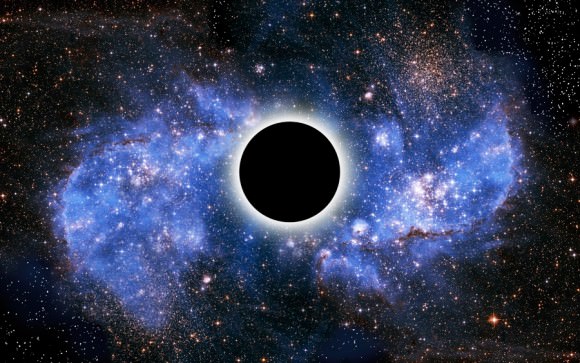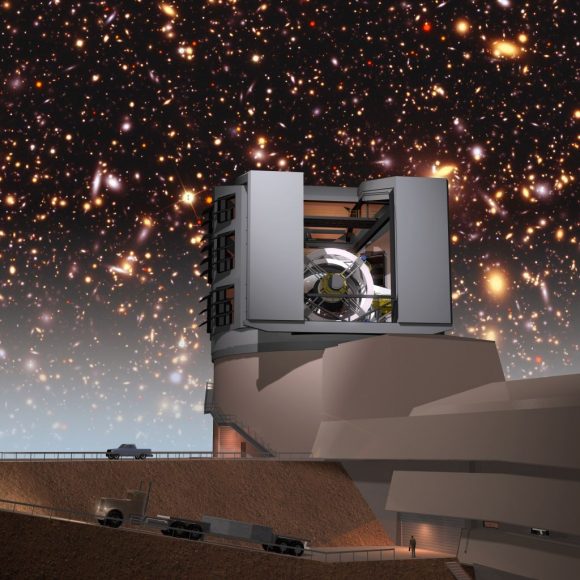At the center of our Milky Way galaxy dwells a behemoth. An object so massive that nothing can escape its gravitational pull, not even light. In fact, we think most galaxies have one of them. They are, of course, supermassive black holes.
Supermassive black holes are stars that have collapsed into a singularity. Einstein's General Theory of Relativity predicted their existence. And these black holes are surrounded by what's known as an event horizon, which is kind of like the point of no return for anything getting too close to the black hole. But nobody has actually proven the existence of the event horizon yet.
Some theorists think that something else might lie at the center of galaxies, a supermassive object event stranger than a supermassive black hole. Theorists think these objects have somehow avoided a black hole's fate, and have not collapsed into a singularity. They would have no event horizon, and would have a solid surface instead.
"Our whole point here is to turn this idea of an event horizon into an experimental science, and find out if event horizons really do exist or not," - Pawan Kumar Professor of Astrophysics, University of Texas at Austin.
A team of researchers at the University of Texas at Austin and Harvard University have tackled the problem. Wenbin Lu, Pawan Kumar, and Ramesh Narayan wanted to shed some light onto the event horizon problem. They wondered about the solid surface object, and what would happen when an object like a star collided with it. They published their results in the Monthly Notices of the Royal Astronomical Society.

Artist's conception of the event horizon of a black hole. Credit: Victor de Schwanberg/Science Photo Library
"Our whole point here is to turn this idea of an event horizon into an experimental science, and find out if event horizons really do exist or not," said Pawan Kumar, Professor of Astrophysics at The University of Texas at Austin, in a press release.
Since a black hole is a star collapsed into a singularity, it has no surface area, and instead has an event horizon. But if the other theory turns out to be true, and the object has a solid surface instead of an event horizon, then any object colliding with it would be destroyed. If a star was to collide with this hard surface and be destroyed, the team surmised, then the gas from the star would enshroud the object and shine brightly for months, or even years.
If that were the case, then the team knew what to look for. They also worked out how often this would happen.
"We estimated the rate of stars falling onto supermassive black holes," Lu said in the same press release. "Nearly every galaxy has one. We only considered the most massive ones, which weigh about 100 million solar masses or more. There are about a million of them within a few billion light-years of Earth."
Now they needed a way to search the sky for these objects, and they found it in the archives of the Pan-STARRS telescope. Pan-STARRS is a 1.8 meter telescope in Hawaii. That telescope recently completed a survey of half of the northern hemisphere of the sky. In that survey, Pan-STAARS spent 3.5 years looking for transient objects in the sky, objects that brighten and then fade. They searched the Pan-STARR archives for transient objects that had the signature they predicted from stars colliding with these supermassive, hard-surfaced objects.
The trio predicted that in the 3.5 year time-frame captured by the Pan-STAARS survey, 10 of these collisions would occur and should be represented in the data.
"It turns out it should have detected more than 10 of them, if the hard-surface theory is true." - Wenbin Lu, Dept. of Astronomy, University of Texas at Austin.
"Given the rate of stars falling onto black holes and the number density of black holes in the nearby universe, we calculated how many such transients Pan-STARRS should have detected over a period of operation of 3.5 years. It turns out it should have detected more than 10 of them, if the hard-surface theory is true," Lu said.
The team found none of the flare-ups they expected to see if the hard-surface theory is true.
"Our work implies that some, and perhaps all, black holes have event horizons..." - Ramesh Narayan, Harvard-Smithsonian Center for Astrophysics.
What might seem like a failure, isn't one of course. Not for Einstein, anyway. This represents yet another successful test of Einstein's Theory of General Relativity, showing that the event horizon predicted in his theory does seem to exist.
As for the team, they haven't abandoned the idea yet. In fact, according to Pawan Kumar, Professor of Astrophysics, University of Texas at Austin, "Our motive is not so much to establish that there is a hard surface, but to push the boundary of knowledge and find concrete evidence that really, there is an event horizon around black holes."
"General Relativity has passed another critical test." - Ramesh Narayan, Harvard-Smithsonian Center for Astrophysics.
"Our work implies that some, and perhaps all, black holes have event horizons and that material really does disappear from the observable universe when pulled into these exotic objects, as we've expected for decades," Narayan said. "General Relativity has passed another critical test."
The team plans to continue to look for the flare-ups associated with the hard-surface theory. Their look into the Pan-STARRS data was just their first crack at it.

An artist's illustration of the Large Synoptic Survey Telescope with a simulated night sky. The team hopes to use the LSST to further refine their search for hard-surface supermassive objects. Image: Todd Mason, Mason Productions Inc. / LSST Corporation
They're hoping to improve their test with the upcoming Large Synoptic Survey Telescope (LSST) being built in Chile. The LSST is a wide field telescope that will capture images of the night sky every 20 seconds over a ten-year span. Every few nights, the LSST will give us an image of the entire available night sky. This will make the study of transient objects much easier and effective.
More reading: Rise of the Super Telescopes: The Large Synoptic Survey Telescope
Sources:
No comments:
Post a Comment